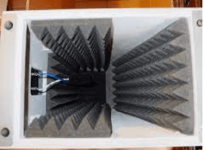HI,
Just a curiosity: normally (as far as I know) the TQWT box design does not use stuffing inside, but looking at the Cube audio boxes (please see the pciture), they use acoustic foam panels. I would like to understand the improverments in sound by using some stuffing against nothing at all.
Just a curiosity: normally (as far as I know) the TQWT box design does not use stuffing inside, but looking at the Cube audio boxes (please see the pciture), they use acoustic foam panels. I would like to understand the improverments in sound by using some stuffing against nothing at all.
Attachments
A Voigt, ideally has a mass loaded terminus. This creates the first lowPass to keep the unwanted harmonics from exiting the terminus and combing with the front output causing ripple.
After that other details determine whether a little or a lot of damping is needed. In some cases one can get away with lining all or some of the walls, or whether some volume fill (well teased fibrous material).
Foam sucks IMO, but is used in commercail loudspeaker because it is consistent.
What Voigt?
dave
After that other details determine whether a little or a lot of damping is needed. In some cases one can get away with lining all or some of the walls, or whether some volume fill (well teased fibrous material).
Foam sucks IMO, but is used in commercail loudspeaker because it is consistent.
What Voigt?
dave
The whole theory about transmission (what a TQWT basicly is) lines including the damping is found here: http://www.quarter-wave.com/TLs/TL_Theory.html
But it's hard to sim how much, that is still try and error largely...
But it's hard to sim how much, that is still try and error largely...
You may have seen this previously, but an interesting YouTube video popped up today on box stuffing, it’s worth watching.
You need to have some damping around the driver to tame midrange refections. Do add stuffing between the driver and the closed end. Stuffing works best at the velocity maxima for any given resonance. So the fundamental resonance that has it velocity maxima at the open end is not affected much by stuffing the the first third of the pipe. Higher harmonics like the 5th resonance that has velocity maxima at 1/5 2/5 3/5 4/5 and 5/5 will be reduced quite a lot by the stuffing. The locations of these maxima is shifted by folds and flares a bit. But the suggested stuffing is a good start.
If going by a lot of ML-Voigt and other pipe-horn Hornresp simulations I've been doing lately, I'll second what DrBoar suggests, as well as P10's suggestion that mass-loading is generally better. I'll add my finding that a driver tap 50% down the line is a good start, but in several cases, a slight offset towards the terminus appears to improve the response. That would be for taps around 55-65%, especially on oversized pipe-horns.
LOL! Me n' MJK had a bit of a disagreement re his 50% MLTQWT Vs my empirically arrived at ~56% MLhorn. Pure TQWTs OTOH have to factor in its end correction and/or boundary loading gain to find the optimal offset.
Of course neither is most technically correct since it's a sliding scale based on throat, terminus area, axial length, so the real question for me becomes how to determine the scaling and how close his and McBean's wave equation solutions are, though strictly a thought problem since I don't believe we can hear the differences except maybe in an extremely rigid [> 10 ga steel or similar MOE that I actually used for damping tests], undamped cab.
Of course neither is most technically correct since it's a sliding scale based on throat, terminus area, axial length, so the real question for me becomes how to determine the scaling and how close his and McBean's wave equation solutions are, though strictly a thought problem since I don't believe we can hear the differences except maybe in an extremely rigid [> 10 ga steel or similar MOE that I actually used for damping tests], undamped cab.
For most 'sensible' bass alignments, the response with a 50% tap is usually quite serviceable. The slight improvements I noticed from a terminus offset driver tap were mostly in the 200Hz-800Hz range, where the response smoothed-out a bit, perhaps barely enough to be readily audible. That was mostly on larger quasi-EBS alignments.
- Home
- Loudspeakers
- Full Range
- TQWT ... adding stuffing or not?
